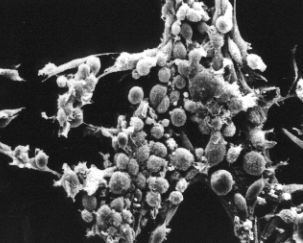12.2: Cancer Cells in Culture
- Page ID
- 5078


The photographs (courtesy of G. Steven Martin) show mouse fibroblasts (connective tissue cells) growing in culture. The cells in the top photo show contact inhibition. Those below do not. The cells below are said to be transformed. These cells (called 3T3 cells) were not derived from a mouse cancer but were produced by laboratory treatment of normal cells. Radiation, certain chemicals, and certain viruses are capable of transforming cells. Although transformed cells are not derived from cancers, they can often develop into malignant tumors when injected into an appropriate test animal (like a nude mouse).
Normal cells are exceedingly fussy about the nutrients that must be supplied to them in their tissue culture medium.
Cancer cells (and transformed cells) can usually grow on much simpler culture medium.
Normal cells ordinarily have the normal set of chromosomes of the species; that is, have a normal karyotype.
Cancer cells almost always have an abnormal karyotype with
- abnormal numbers of chromosomes (polyploid or aneuploid)
- chromosomes with abnormal structure:
- translocations
- deletions
- duplications
- inversions


